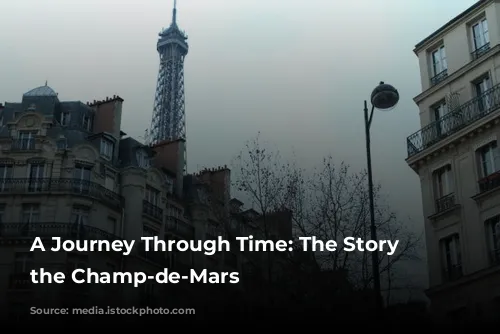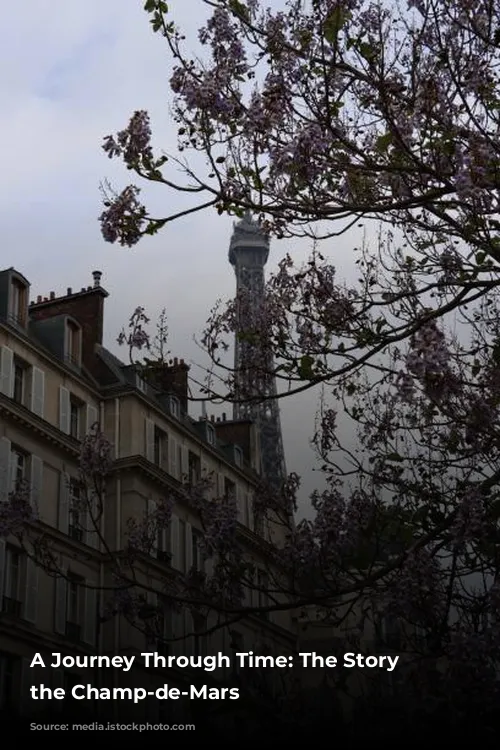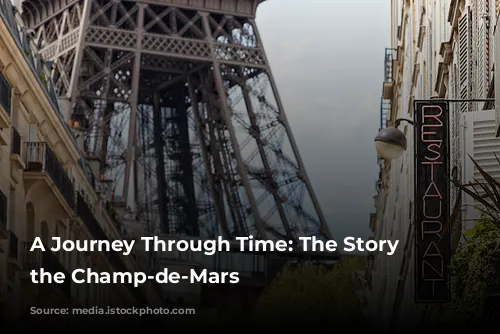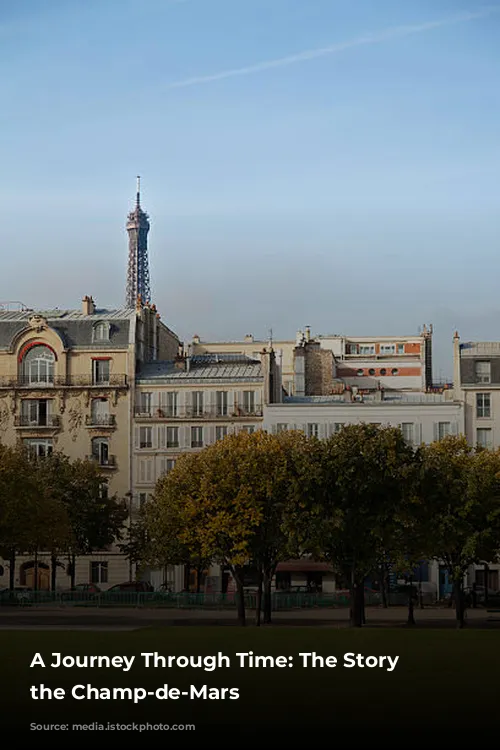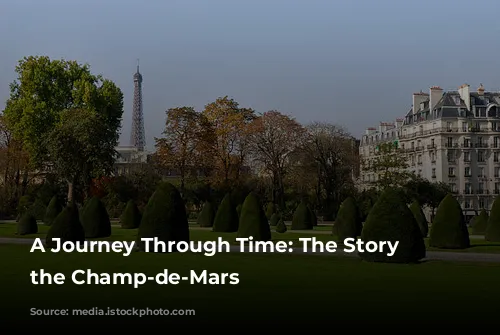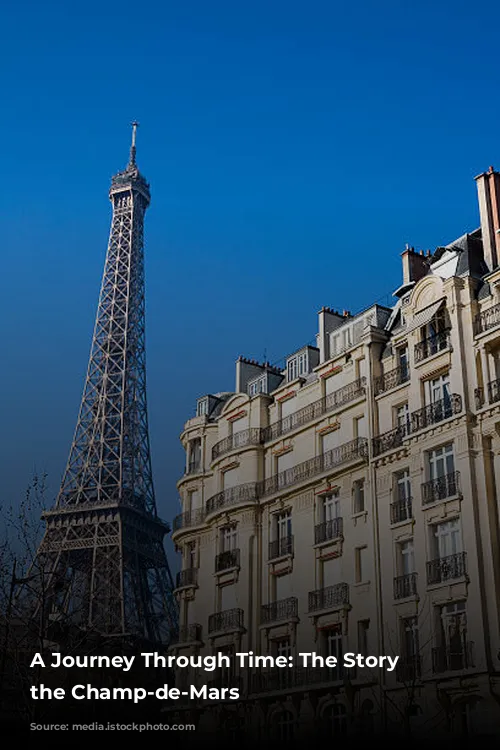Welcome to the Champ-de-Mars, a sprawling green expanse at the foot of the iconic Eiffel Tower. Today, it’s a beloved spot for Parisians and visitors alike, a place to relax, picnic, or simply soak in the breathtaking views. But this tranquil park has a rich history, one that’s been shaped by war, revolution, and the spirit of innovation.

From Military Grounds to a Parisian Paradise
The name “Champ-de-Mars” itself has roots in Roman mythology, referring to spaces dedicated to military parades and maneuvers. This concept was adopted across many garrison towns, including Paris, with vast areas designated as training grounds for soldiers. These spaces were named in honor of Mars, the Roman god of war.
While some municipalities have preserved their Champ-de-Mars, Paris’s stands out for its unique and pivotal role in French history.
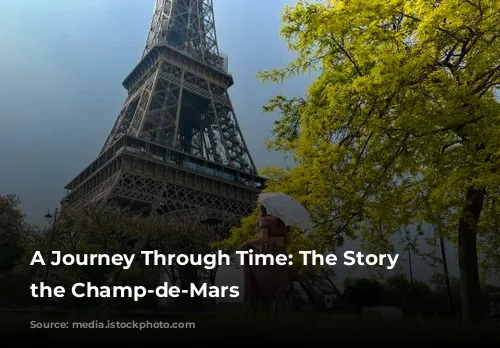
A Place of Transformation: From Esplanade to Exhibition Ground
The Champ-de-Mars in Paris has seen numerous transformations over the centuries. In the 16th century, it was a sprawling expanse of gardens and vineyards, a testament to the agricultural landscape of the era. This peaceful scene would soon give way to a more active use.
Beginning in the 18th century, the Champ-de-Mars evolved into a grand military training ground. Its vast size allowed for the deployment of thousands of soldiers, reinforcing its connection to the god of war. The area was closed to the public, protected by imposing iron gates.

A Stage for History: From Revolution to Races
The French Revolution brought a dramatic shift to the Champ-de-Mars. The revolutionaries recognized the grandeur of the space and transformed it into a site for monumental events. Notably, the storming of the Bastille, a pivotal moment in the French Revolution, is celebrated annually on July 14th, a tradition that began in 1790.
The Champ-de-Mars continued to evolve, hosting a variety of events that captivated Parisians. During the Belle Époque, horse races were a major attraction, drawing crowds from all walks of life. This equestrian tradition still resonates today, with the famous “Jappeloup” jubilee in 1991 showcasing the world’s top riders in a dazzling display of show jumping.

A Haven for Innovation: The Universal Exhibitions and the Eiffel Tower
The 19th century saw the Champ-de-Mars become a hub for global innovation, hosting the renowned Universal Exhibitions. Prior to this, the exhibitions were held in the Trocadéro Gardens, but the Champ-de-Mars offered a larger and more impressive setting.
The 1889 Universal Exhibition stands out for its pivotal role in shaping the Parisian skyline. The iconic Eiffel Tower was constructed for this event, permanently altering the landscape of the Champ-de-Mars and becoming a global symbol of Paris. It was during this exhibition that the army transferred ownership of the Champ-de-Mars to the City of Paris, paving the way for its transformation into a public park.

A Celebration of Life: A Gathering Place for Generations
The Champ-de-Mars holds a special place in the hearts of Parisians and remains a popular gathering place for events of national importance. The site has witnessed joyous celebrations of victory, like the joyous celebrations following the French national football team’s World Cup wins in 1998 and 2018.
Beyond these monumental moments, the Champ-de-Mars is a place where Parisians and visitors alike enjoy everyday life. Strolling beneath the Eiffel Tower, picnicking on the expansive lawns, or simply watching the sunset over the cityscape, the Champ-de-Mars offers a tranquil escape in the heart of Paris.

A Green Oasis in the City: A Haven for Nature and Recreation
Today, the Champ-de-Mars is one of Paris’s largest green spaces, stretching across 24.5 hectares. It’s unique in being the only public garden in Paris that remains open 24/7, providing a welcome respite from the bustling city.
Inspired by both French and English garden designs, the Champ-de-Mars park is a symphony of green spaces. Rolling lawns, meandering pathways, and majestic bronze statues invite visitors to explore and relax. Its beauty has earned it recognition as a UNESCO World Heritage site.
The Champ-de-Mars is also a haven for biodiversity. Its diverse tree species attract a variety of birds, including species typically found in the vast French forests. Even a tawny owl, a nocturnal creature rarely seen in the city, calls this park its home.
The Champ-de-Mars is a truly unique space, open to all. With no barriers or gates, it offers a free and accessible space for events, concerts, rallies, and sporting events. And in 2024, it will play host to a selection of events during the Paris Games, adding yet another chapter to its rich history.
The Champ-de-Mars, from its humble beginnings as a military training ground to its current role as a vibrant public park, continues to evolve and inspire. A testament to Paris’s resilience and the enduring power of public spaces, the Champ-de-Mars stands as a timeless symbol of the city’s beauty, history, and the joy of community.
